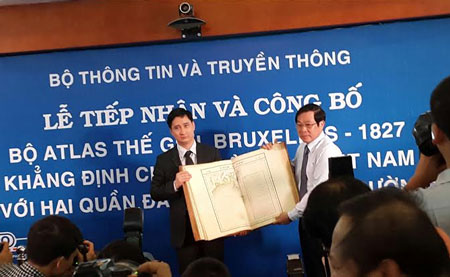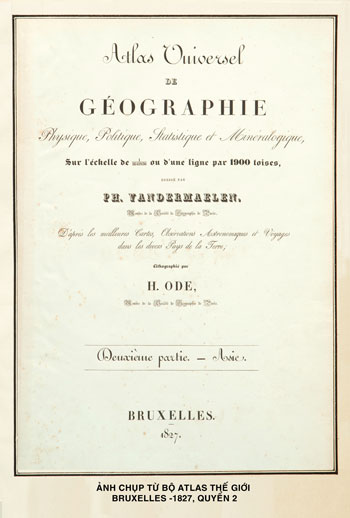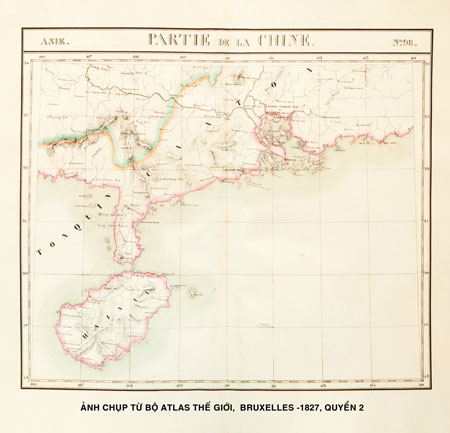World atlas testifies to archipelago sovereignty

>> China-Vietnam incident 'extremely serious': ASEAN
>> Sri Lanka supports VN’s standpoint on East Sea
>> East Vietnam Sea disputes must be resolved peacefully: US Assistant Secretary of State
The Ministry of Information and Communications displayed the maps to the public in Ha Noi to raise awareness about the nation's indisputable sovereignty, Minister Nguyen Bac Son said.
Professor Nguyen Quang Ngoc from Ha Noi National University, vice chairman of the Vietnam Historical Science Association, found the maps at a bookstore in Belgium.

Aware of the importance of the document, the Ministry of Information and Communications purchased the atlas with support from Ngo Chi Dung, director of ECO Pharmaceutical Company.
Vandermaelen (1795-1869) was a famous Belgian cartographer and eminent geographer. He was a member of the Paris Geography Association and founder of the Belgian Royal Geography Association.
The World Atlas, published in 1827, is one of the works that made him famous. It comprises six volumes with seven general maps of five continents, 381 detailed maps, 40 pages of statistics and chapters on natural, political and mineral geography. All the maps can be pieced together into a globe measuring 7.75m in diameter.
 |
| Evidence: The 1827 World Atlas's Asian volume has 111 maps. Viet Nam's territory is included in four detailed maps including "Partie de la Cochinchine", which indicates clearly that the Paracels was recognised as part of Viet Nam (known in the West at that time as Cochinchine). |
"This is a great landmark for the development of map printing and drawing technology in the early 19th century," said Ngoc.
The Asian volume has 111 maps. Viet Nam's territory is included in four detailed maps including "Partie de la Cochinchine", which indicates clearly that the Paracels was recognised as part of Viet Nam (known in the West at that time as Cochinchine).
The map reflects scientific accuracy of a very high level, according to Prof Ngoc. The Paracels were drawn in detail and the map includes an introduction on the geography, politics, minerals and statistics of the Empire of An Nam (the former name of Viet Nam).

Prof Ngoc also worked on the "Partie de la Chine" showing Guangdong and Hainan, China's southernmost boundary. All Chinese maps from the 20th century backwards are identical to the Western maps, with no indication that China's southernmost territory extends beyond the 18th latitude, while the Paracels stretched from about the 16th latitude to the 17th latitude.
"China has no sovereignty over the Paracels," said Ngoc. "The World Atlas in general and the ‘Partie de la Cochinchine' in particular can be considered priceless documents as well as convincing evidence for the sacred sovereignty of Viet Nam."
Ngoc has researched a hundred Western maps, but he said the World Atlas was the most detailed, accurate and clear evidence proving Viet Nam's sovereignty over the sea area.
What the stars mean:
★ Poor ★ ★ Promising ★★★ Good ★★★★ Very good ★★★★★ Exceptional
Latest News
More News
- Green-digital transition must start with proper mindset (November 13, 2024 | 16:49)
- New Zealand shares sustainable development experience with Vietnam (November 13, 2024 | 15:55)
- Vietnam on the verge of green industrial revolution (November 12, 2024 | 15:57)
- VIR sustainable development conference opens in Hanoi (November 12, 2024 | 09:42)
- Taking the lead in dual transition for a greener Vietnam (November 11, 2024 | 17:00)
- Vietnamese consumers careful amid economic volatility (November 11, 2024 | 13:55)
- Quality must come first in chip mission (November 11, 2024 | 10:33)
- Vietnam's digital economy estimated to reach $36 billion in 2024 (November 07, 2024 | 13:52)
- Authorities looks to tackle influx of cheap foreign goods (November 07, 2024 | 10:44)
- Trump claims 'magnificent' victory over Harris (November 06, 2024 | 16:55)




















 Mobile Version
Mobile Version